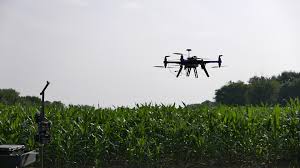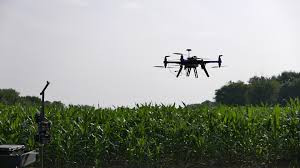
While drones are gaining popularity very fast, working on counter-drone systems as small consumer and commercial drones proliferate is Silicon Valley startup Airspace Systems and some 70 companies. But instead of disabling them or shooting them down, it aims to catch drones, unlike others.
A compact aircraft just a few feet wide, yet capable of sophisticated, autonomous navigation and accurate targeting of a drone in motion was showed at a demonstration at Airspace headquarters in San Leandro, California.
In the drone-defense business, it is still early days. Threats to security at military sites, airports, data centers, and public venues like baseball stadiums have become a cause for worry for security professionals both public and private. However counter-measures are also risk.
For example, experimental shotgun shells for shooting down drones were recently tested by the U.S. Air Force. But it could still fall on its target with a payload like a bomb or chemical weapon if the drone carries such a payload.
And it has not always been successful trying to Jam the radio signals to the drone. Since they can fly to pre-set coordinates autonomously, drones differ from “remote-controlled” aircraft. Further some drones can be too quick for human pilots flying another drone to catch as the fastest drones can reach 150 miles per hour (240 km).
Guy Bar-Nahum, one of the inventors of the Apple iPod and the engineering brains behind Airspace Systems, found it appealing - the technical challenge of safely stopping a dangerous drone.
"We are creating a very primitive brain of an insect, a dragonfly," Bar-Nahum said. "It wakes up, sees the world and doesn't really know where it is. But it has goals to capture the other drone, and it's planning a path in the world and knows how to move through the world."
Computing power and sophisticated software needs to be packed into that tiny drone brain by the interceptor. And without the benefit of an internet connection to a massive mapping database, it has to understand its environment, unlike the emerging driverless car.
“My background is in physics, and it’s all about modeling the world” with math, Bar-Nahum said. “What we do in this lowly startup that looks to be a normal, military ‘take ‘em down’ kind of company is build machines that can model the world.”
Business models of this sort is challenging also. The authority to interfere with another drone's flight is currently only with the law enforcement officials. A certified pilot has to keep a line-of-sight view of the aircraft and stand ready to intervene in any commercial drone flight according to regulations.
A system, complete with operators and a mobile command center, would be leased to customers instead of selling its aircraft by the Airspace Systems.
According to Sterling VC, the venture capital arm of Sterling Equities, which owns the stadium and also invested in Airspace,, the New York Mets have an interest in using the system to protect Citi Field in New York City.
When the U.S. military said Islamic State fighters were using them to attack Iraqi troops in the battle over Mosul in the last few months, the danger from hostile drones have became more clear. Including an agile quadcopter version for dropping explosives, ISIS was using an array of consumer-style drones, the military news site Defense One reported.
(Sorce:www.reuters.com)
A compact aircraft just a few feet wide, yet capable of sophisticated, autonomous navigation and accurate targeting of a drone in motion was showed at a demonstration at Airspace headquarters in San Leandro, California.
In the drone-defense business, it is still early days. Threats to security at military sites, airports, data centers, and public venues like baseball stadiums have become a cause for worry for security professionals both public and private. However counter-measures are also risk.
For example, experimental shotgun shells for shooting down drones were recently tested by the U.S. Air Force. But it could still fall on its target with a payload like a bomb or chemical weapon if the drone carries such a payload.
And it has not always been successful trying to Jam the radio signals to the drone. Since they can fly to pre-set coordinates autonomously, drones differ from “remote-controlled” aircraft. Further some drones can be too quick for human pilots flying another drone to catch as the fastest drones can reach 150 miles per hour (240 km).
Guy Bar-Nahum, one of the inventors of the Apple iPod and the engineering brains behind Airspace Systems, found it appealing - the technical challenge of safely stopping a dangerous drone.
"We are creating a very primitive brain of an insect, a dragonfly," Bar-Nahum said. "It wakes up, sees the world and doesn't really know where it is. But it has goals to capture the other drone, and it's planning a path in the world and knows how to move through the world."
Computing power and sophisticated software needs to be packed into that tiny drone brain by the interceptor. And without the benefit of an internet connection to a massive mapping database, it has to understand its environment, unlike the emerging driverless car.
“My background is in physics, and it’s all about modeling the world” with math, Bar-Nahum said. “What we do in this lowly startup that looks to be a normal, military ‘take ‘em down’ kind of company is build machines that can model the world.”
Business models of this sort is challenging also. The authority to interfere with another drone's flight is currently only with the law enforcement officials. A certified pilot has to keep a line-of-sight view of the aircraft and stand ready to intervene in any commercial drone flight according to regulations.
A system, complete with operators and a mobile command center, would be leased to customers instead of selling its aircraft by the Airspace Systems.
According to Sterling VC, the venture capital arm of Sterling Equities, which owns the stadium and also invested in Airspace,, the New York Mets have an interest in using the system to protect Citi Field in New York City.
When the U.S. military said Islamic State fighters were using them to attack Iraqi troops in the battle over Mosul in the last few months, the danger from hostile drones have became more clear. Including an agile quadcopter version for dropping explosives, ISIS was using an array of consumer-style drones, the military news site Defense One reported.
(Sorce:www.reuters.com)














